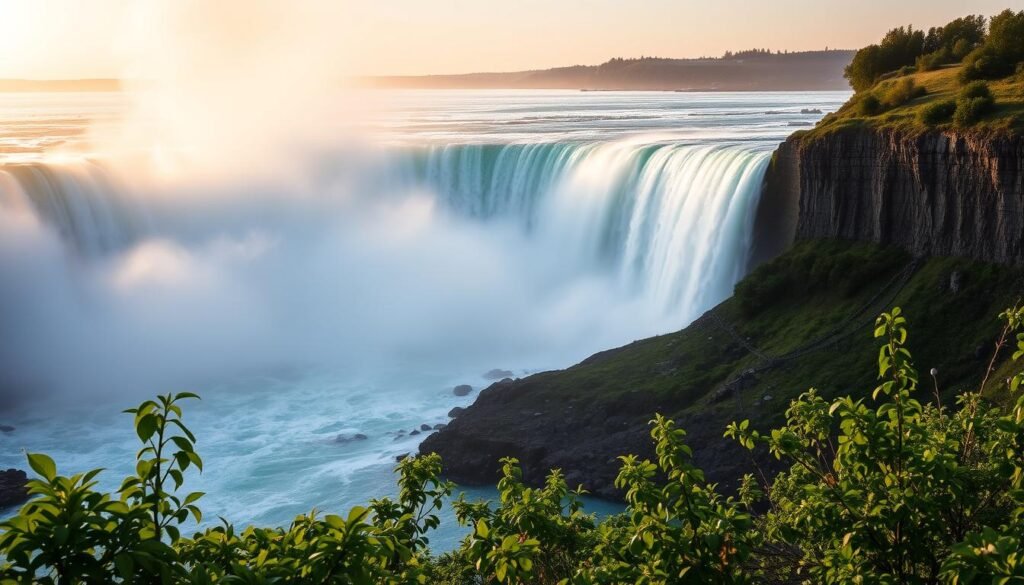Did you know the Horseshoe section plunges over 164 feet and makes it the most powerful waterfall in North America? I still find that fact startling when I stand near the roar.
I write this as someone who has watched this spectacular natural scene change with every season. The falls are actually three falls — Horseshoe, American, and Bridal Veil — and the water show is free and open 365 days a year.
My aim is simple: help you pick when warmth, smaller crowds, or icy panoramas matter most. The Canadian side gives that straight‑on postcard view and access to Journey Behind the Falls, while the U.S. side offers quiet trails inside Niagara Falls State Park.
I also note travel practicalities: major gateways include Toronto Pearson and Buffalo Niagara airports, and crossing the border is straightforward with a passport. For a seasonal rundown and practical tips, see this helpful seasonal guide.
Key Takeaways
- Horseshoe Falls is over 164 feet and hugely powerful.
- The panorama is free year‑round; your priorities define the ideal moment.
- Canadian side for views; U.S. side for park trails and calm walks.
- Summer has full operations but bigger crowds; spring and fall balance weather and savings.
- Winter offers icy beauty and light displays, though some activities pause.
Quick Answer: When I Think the Best Time to Visit Niagara Falls Is
For me, the ideal window balances sunny weather and far fewer visitors. If you want my bottom line, I aim for early to mid‑June or mid‑September. Those dates give me warm weather, most attractions open, and lighter crowds than the heart of summer.
June means boat cruises, observation points, and evening lights are running while schools are wrapping up, so day‑to‑day pressure from visitors is more manageable.
- Mid‑September holds lingering warmth, vivid sunsets, and shorter lines after Labor Day.
- July and August deliver peak energy and late sunsets, but expect longer queues and book hotels early.
- Spring and fall shoulders give easier parking and better last‑minute availability than summer.
“I always block an extra day on either side of my main visit to pivot around rain or heavier crowds.”
Remember that niagara falls is free 365 days a year, so I pick the day that matches the experience I want.
best time to visit niagara falls: Crowd, Weather, and Water Flow Trade‑offs
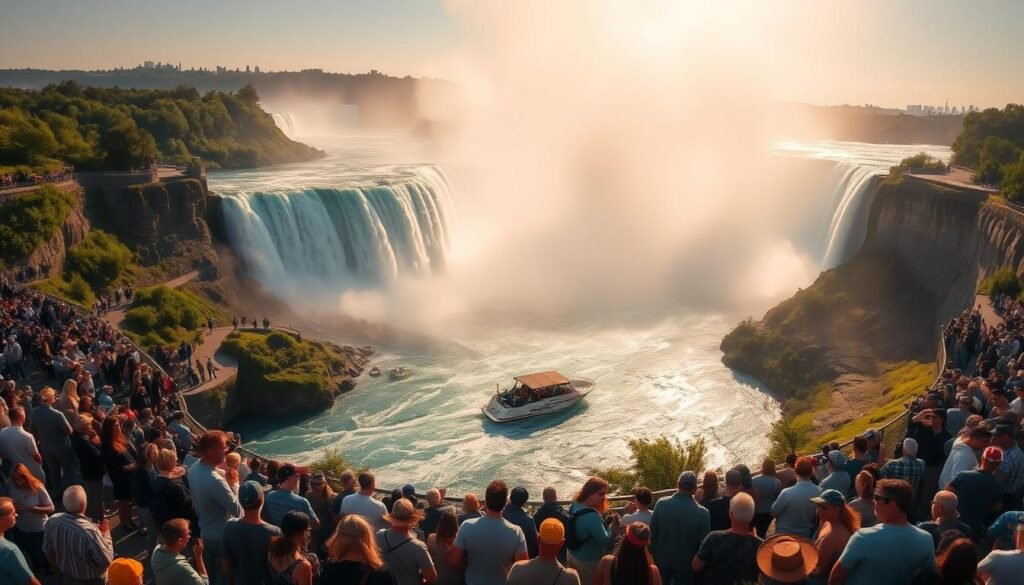
Choosing when to go is really a balancing act between crowds, weather, and how the water shows up. I sort priorities first and then plan my days around windows with lighter foot traffic.
Peak summer brings warm days, long daylight, and every attraction open across the area. I love that energy, but I also plan early starts and timed entries to beat the biggest crowds.
Peak summer: warm weather, long hours, biggest crowds
In peak months I expect long lines and busy overlooks. I book key experiences in advance and aim for sunrise photos when possible.
Shoulder seasons: fewer visitors, great views, better hotel value
April–May and September–October usually give milder weather, easier parking, and clearer railings for photos.
Late May or mid‑to‑late September often strike the best balance of open attractions and manageable crowds.
Winter magic: icy scenes, lights, limited boat tours
Winter flips the script. Ice frames the gorge and the Festival of Lights brightens nights, though some boat tours pause. If I want quiet, I bundle up and enjoy the slow pace.
- My tip: If comfort matters, prioritize weather and leave flexibility in your schedule.
- For empty shots: I go sunrise or late evening on weekdays to dodge peak weekend crowds.
“Water flow impresses year‑round, but summer often lines up with the most activity and the longest access hours.”
Season-by-Season Guide to Visiting the Falls
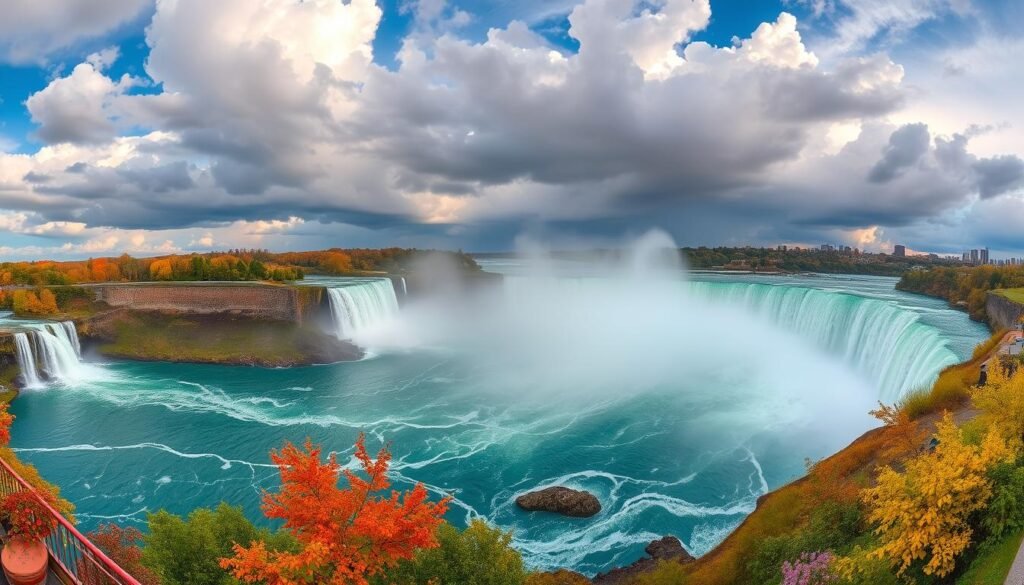
Seasons here rewrite the scene, and I shape my plans around what each one offers.
Spring (April–May)
I aim for late April through May for milder temperatures and fresh greenery in Niagara Parks. This window often sees the first openings of Maid of the Mist and Niagara City Cruises, so the early boat tour departures are a highlight.
Summer (June–August)
Summer brings warm weather, peak flow, and full operations. I build in extra days for lines and chase both daytime spray and nightly illumination on clear evenings.
Fall (September–October)
Fall delivers crisp air and vivid foliage. I pair gorge views with winery events and scenic drives for relaxed days around the region.You can learn about best-time-to-visit-puerto-rico
Winter (November–March)
Winter layers ice and lights across the gorge. I bundle up, plan indoor warmups between outdoor shots, and check the Festival of Lights schedule.
| Season | Highlights | My Tip |
|---|---|---|
| Spring | Blooming parks, early boat tours | Go late April–May for milder temperatures |
| Summer | Full operations, evening lights | Allow two days for headline activities |
| Fall | Foliage, winery events | Plan scenic drives and tastings |
| Winter | Frozen vistas, Festival of Lights | Layer up and warm between outings |
“I check boat and attraction calendars before booking so my plans match operating windows.”
American Side vs Canadian Side: How I Choose My View
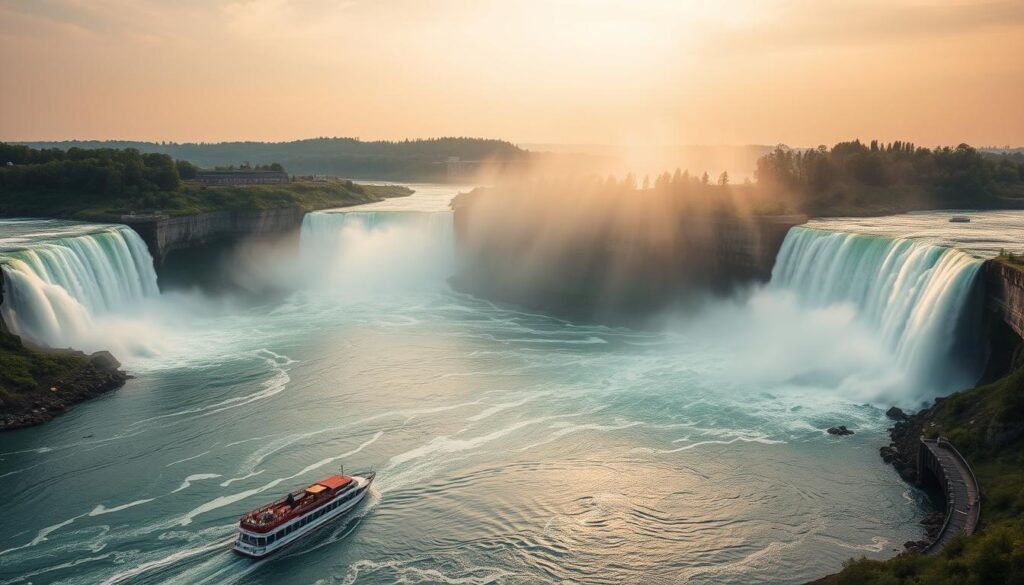
When I pick a vantage, I weigh close‑up power against postcard panoramas. The two sides offer very different experiences, so I match my plan to what I want that day.
American option: state park serenity
I head to the american side when I want quiet trails and full spray. Niagara Falls State Park feels natural and protected.
Cave of the Winds, Maid of the Mist, and the Observation Tower put me river‑level and face‑to‑face with the waterfall for raw drama.
Canadian option: straight‑on panorama
On the canadian side I chase the classic sweep. Journey Behind the Falls and Skylon Tower give elevated views and dining with a skyline backdrop.You can learn about best-places-to-visit-in-december
The canadian sides pack hotels and restaurants, which makes lingering after sunset easy.
Crossing the Rainbow Bridge: quick tips
I often walk the bridge to get both perspectives. Bring your passport and allow about 30 minutes for the walk and border checks.
- I use observation decks on each side for different angles — side‑on drama in the U.S., head‑on power from Canada.
- If I have limited hours, I pick the side that fits my priority: immersive spray or the postcard view.
“When I can, I split a day between both sides for a complete picture.”
Top Experiences by Time of Year
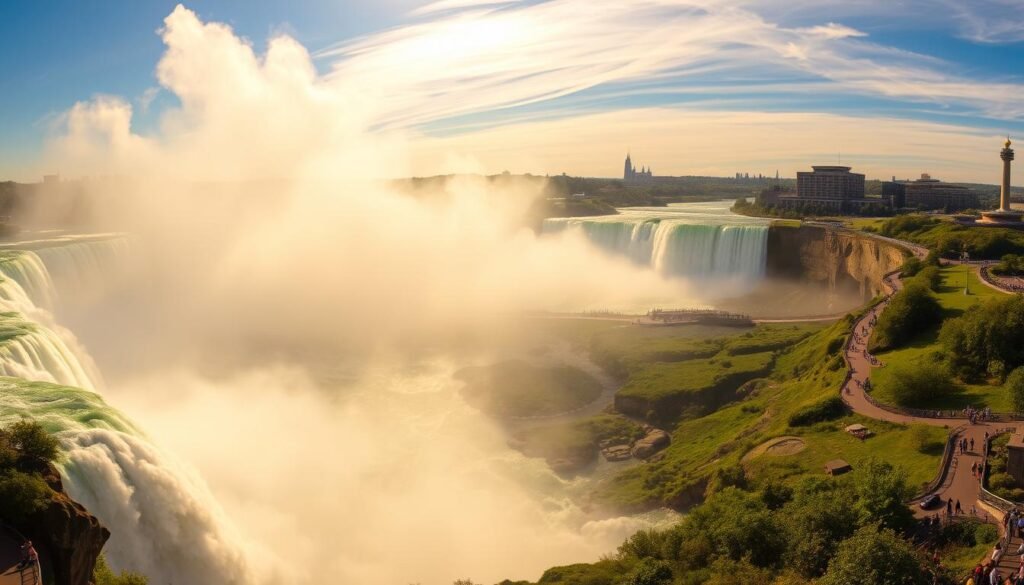
I pick activities around what the day will let me do — close spray, skyline dining, or broad aerial shots. Below I map which experiences I aim for in each season and why.
Boat rides and seasonal runs
Boat tour options run mainly spring through fall. Maid of the Mist operates on the American side, while Niagara City Cruises sails from the canadian side. Both give heavy mist and ponchos, so I book morning sailings for clearer photos.
Observation decks and towers
I pair Skylon Tower’s dining and sweeping skyline with the Niagara Falls Observation Tower for a dramatic US‑side angle. These observation decks are my go‑to when wind or kids make a boat impractical.
Helicopter tours and scenic viewpoints
On clear days I take a helicopter tour to capture the full curve of Horseshoe and the river ribbon. Aerial tours give unique views that no ground lookout can match.
Evening illumination and fireworks
Night lights run mainly in summer with fireworks on select nights. I aim for midweek evenings to avoid crowds and still catch bright colors over the waterfall.
| Experience | Seasonal Window | My Tip |
|---|---|---|
| Maid of the Mist / Niagara City Cruises | Spring–Fall | Book morning sailings; bring a poncho |
| Skylon Tower & Observation Tower | Year‑round (weather dependent) | Save towers for windy or rainy days |
| Helicopter tours | Late spring–early fall (clear days) | Reserve early and pick a calm day |
| Illumination & Fireworks | Summer nights (select dates) | Go midweek for lighter crowds |
“My favorite combo: a late afternoon boat, dinner at Skylon, then night lights for a perfect loop.”
My Ideal Itineraries by Month
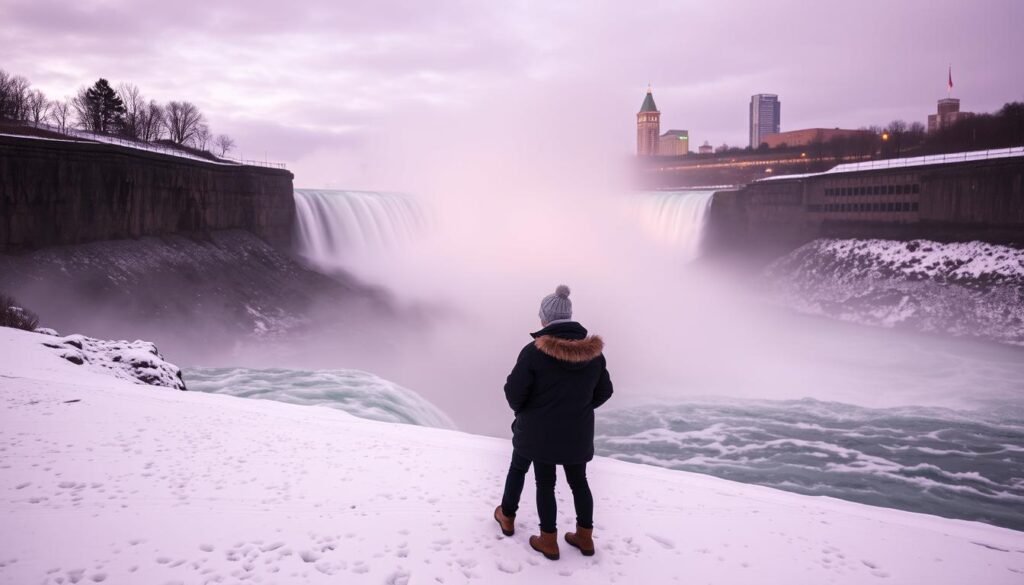
When I craft an itinerary, I lock in one clear aim for each day and keep a flexible slot for weather or delayed openings. Below are three practical plans I use when I want different experiences around the falls.
June weekend: warm weather, boat tour, Falls illumination
I arrive Friday, check into a Fallsview hotel, and catch sunset views before a stroll under the night lights.
Saturday is the action day: a morning boat tour to beat lines, lunch with a view, Journey Behind the Falls, and a tower lookout before dinner.
I cap the night with illumination and fireworks if scheduled. Sunday morning I take a quiet walk along a short gorge trail before heading home.
September midweek: lighter crowds, wine country add‑on
I land Tuesday for lighter crowds and plan a relaxed Wednesday at the main overlooks.
Thursday becomes a pleasant escape to Niagara‑on‑the‑Lake vineyards and scenic drives. Mid‑September keeps temperatures mild and parking easier than peak months.
January escape: lights, cozy dining, indoor attractions
In winter I center the plan on indoor comforts. I book a centrally located hotel and plan warm‑up stops at cafés and museums.You can learn about best-time-to-visit-grand-canyon
Outdoor windows are short, so I pick the warmest part of the day for photos and save one flexible block to swap in a tower visit if wind cancels the mist boat option.
“I always leave a final quiet viewpoint on the last day — one last look at the mist before I go.”
- Quick tip: Aim for an early morning or late evening session on any day for thinner crowds and better light.
What to Pack for Each Season
Packing right can make a day at the gorge feel effortless instead of frantic. I plan gear around likely weather and the amount of spray near the water.
- I pack quick‑dry shirts, a light waterproof jacket, and a spare pair of socks because the mist soaks through more than I expect.
- Layers help when temperatures shift; I carry a base tee, a light fleece, and a shell for flexible warmth.
- A compact poncho is a must for boat decks and Journey Behind the Falls — even with provided ponchos, my bag and shoes stay drier with an extra layer.
- Grippy, closed‑toe shoes with good drainage work well during warm weather and wet boardwalks.
Winter kit
- In winter I wear thermals, a windproof parka, a warm hat, and touchscreen gloves; the gorge can feel colder and windier than forecasts suggest.
- Insulated, waterproof boots and traction devices keep me steady on icy paths near the railings.
I also pack small essentials year‑round: sunglasses and a microfiber cloth for glare and spray, a dry bag for my phone and camera, a portable battery for maps and tickets, and lip balm and hand cream for comfort.
- A lightweight daypack with a chest strap keeps gear secure while I grab photos.
- I find that a small towel and spare cloths help after a mist‑heavy session along the railings.
With the right kit, every visit to niagara falls feels smoother and more enjoyable, so I can focus on the view instead of soggy gear.
Where I Stay for the Best Views and Value
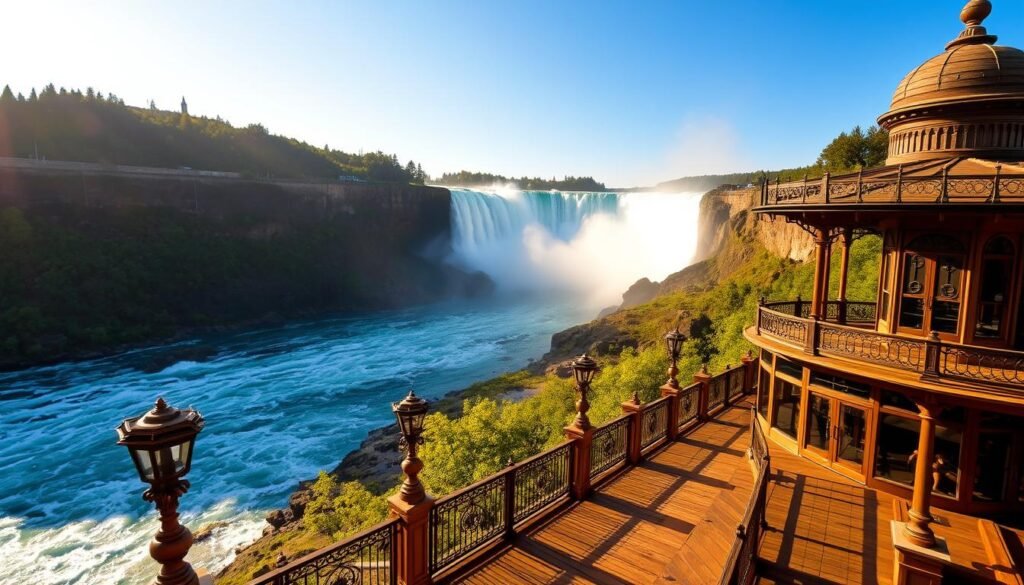
When I pick a place to sleep near the gorge, I aim for views that wake me before my alarm. A smart choice saves walking time and turns downtime into extra lookout moments.
Fallsview hotels for that straight‑on panorama
For that iconic panorama, I choose Fallsview properties such as Sheraton on the Falls, Crowne Plaza Niagara Falls‑Fallsview, or Niagara Falls Marriott on the Falls. These hotels put the Canadian side panorama in easy reach.
Budget stays and when I book
If I’m hunting value, I book shoulder seasons or midweek stays when rates drop. For summer weekends I reserve early and ask for upper floors for the widest window view.
- I weigh location vs. price: steps from the railings save time for quick photo runs.
- Families get pools and onsite dining; couples may prefer rooms with floor‑to‑ceiling views.
- I compare parking fees, resort charges, and cancellation policies before I commit.
“I often split nights between the panorama side and a quieter area when I want both viewpoints and trail access.”
Choosing the right hotel or accommodation shapes how much of niagara falls I see without extra planning.
Getting There: Airports, Trains, and Driving Tips
![]()
Getting here is easier than many expect, but small choices shape how much of the view you get on day one. I pick transport based on how much walking I want and how many stops I plan along the route.
Fly: I often use Toronto Pearson (about 78 miles away) or Buffalo Niagara International for the quickest access. If I fly into Niagara Falls International (NY) I allow a short shuttle or drive. When I plan to cross the border, I keep my passport handy and add extra time.
Drive: From Toronto I take the Queen Elizabeth Way (QEW) along Lake Ontario and budget roughly two hours in good traffic. I arrive early for central parking near observation points and check posted rates and limits.
Rail, bus, and guided options
I like VIA Rail for a relaxed rail link from Toronto, then a short local ride to main viewpoints. Megabus and Greyhound run affordable routes from major cities for a simple day or overnight trip.
For a stress‑free plan, I sometimes join a guided tour from Toronto that bundles transport, a boat, and a couple of scenic stops.
| Option | Range | My Tip |
|---|---|---|
| Toronto Pearson | ~78 miles | Drive QEW; allow 2 hours |
| Buffalo Niagara Intl. | Well served from US | Good for US‑side arrival |
| VIA Rail / Bus | Daily service | Great for car‑free day trips |
| Niagara Falls Intl. (NY) | Local flights | Carry passport if crossing side |
“No matter how I arrive, I save my favorite viewpoint for a time when light and weather cooperate for the best first impression.”
Timing Your Visit: Hours, Days, and Avoiding the Rush
![]()
A little scheduling goes a long way — a sunrise stroll often beats the midday crush. I plan around light, local operating hours, and when the railings feel calm.
Early mornings bring ethereal light and far fewer crowds. I also like late evenings when illumination adds drama without the heavy foot traffic.
Early mornings and late evenings for fewer crowds
I book first or last slots for boat rides and marquee attractions to shorten lines. Sunrise photos are quieter, and evening shots pair well with the light displays.
Weekdays vs weekends, holidays, and school breaks
Weekdays usually beat weekends, and mid‑September through October weekdays feel much calmer than peak summer months. I check school calendars and skip long holiday weekends when possible.
- I allow extra time for the Rainbow Bridge crossing — about 30 minutes including border formalities and photos; carry your passport if you plan to cross.
- On hot summer days I do up‑close spray activities early, saving shaded or indoor stops for midday.
- When forecasts shift, I move photo walks to clearer hours and keep one flexible slot for must‑do attractions.
“The key is balancing my must‑dos with the smartest hours so I enjoy the power of the falls without the press of visitors.”
My Favorite Seasonal Side Trips
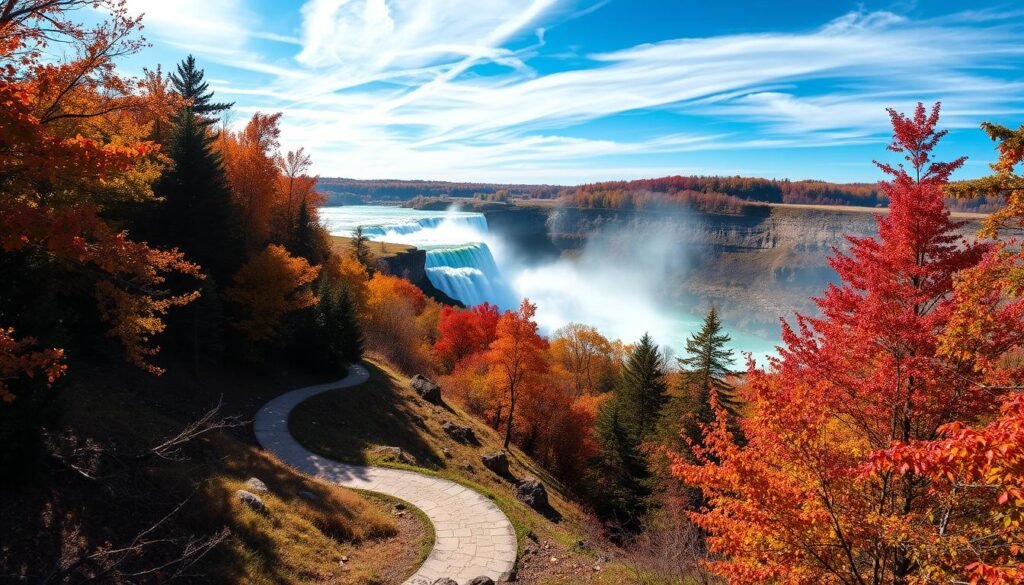
When I have an extra block in my itinerary, I pick short escapes that match the season and mood of the day.
Summer escapes and adrenaline
In summer I chase Whirlpool Jet Boat tours for a high-energy splash, then cool down with a hike at Devil’s Hole State Park. The riverside trails give dramatic gorge views and fresh air.
I often add a Maid of the Mist ride if I’m on the U.S. side, then grab a casual cone at De Dee’s Dairy for a relaxed finish.
Fall vineyards and harvest fun
Fall means a road trip to Niagara-on-the-Lake for winery tastings and harvest events. I stop at Donovan Orchards or Becker Farms for cider and pumpkin picking when the leaves are vivid.
Winter warmth and indoor treats
On cold days I warm up at Platter’s Chocolate Factory and swap long hikes for short photo bursts between indoor exhibits. A cozy dinner at Bella Vista Ristorante lets me savor local flavors without a freeze.
- Check Artpark for summer concerts before you plan an evening outing.
- Plan side trips on lighter days so you’re not rushed between attractions.
- If you only have a half‑day, pick jet boats in summer or wineries in fall for the most impact.
“Side trips expand the view beyond the railings and show the area’s natural beauty and local culture.”
Budgeting Your Trip: Free Views vs Paid Attractions
I always remind myself that the core experience is free; standing at the railing and watching the water costs nothing any day of the year.
Paid options — like a boat tour, Journey Behind the Falls, tower entries, and helicopter rides — add different angles and photo ops. I pick one or two highlights and use free overlooks for the rest of my day.
If I’m tight on cash, I compare single tickets with bundled passes and day tours, especially when I pay for transport from Toronto. Shoulder months cut accommodation rates and often reduce waits.
Families should check hotel deals that include credits or attraction discounts. I also balance one splurge meal with casual choices to keep the trip affordable.
- I reserve major paid items in advance on peak dates to avoid sellouts and surge pricing.
- I plan the schedule so I don’t rush through a paid attraction after paying full price.
“With a smart mix of free vistas and a couple of paid experiences, I craft a memorable day without overspending.”
For extra budget ideas, see these budget tips for the Canadian side.
Safety, Weather Checks, and Etiquette Near the Falls
I treat each trip as a short weather expedition, so I check conditions before I leave. The weather at the railings can be cooler and windier than inland. That change affects how long I stay and what I wear.
I wear stable shoes with good grip because mist and wet boards make surfaces slick. In winter, low temperatures and ice mean I add traction aids and extra layers. I also keep snacks and water in my daypack so I don’t push myself when the area gets busy.
I follow posted guidance on each side and stay behind barriers. Signs exist to protect against fast water and steep edges. For kids, I hold hands at crowded lookouts and keep bags off railings so nothing blows over.
- I stay aware when I photograph so I don’t block narrow paths.
- I give other visitors room at the railings; a small courtesy helps everyone.
- If winds pick up, I switch to an indoor exhibit or a tower and return later.
| Risk | Why | Action I Take |
|---|---|---|
| Slippery surfaces | Mist and spray make boards slick | Wear grippy shoes; use traction aids in winter |
| Strong wind | Wind increases near the gorge | Secure hats; move indoors until calm |
| Crowded lookouts | Narrow paths and many visitors | Keep space at railings; hold kids’ hands |
| Rapid weather shifts | Local conditions can change fast | Check forecast before setting out; adjust plans in time |
“A little etiquette and weather awareness go a long way toward a smooth, memorable visit.”
When Boat Tours Run and How to Pick the Right One
I pick a boat based on where I start and how close I want to get to the curtain of spray. Both major operators run seasonally, and knowing which dock you’ll use saves hassle and aligns the day with your goals.
Maid of the Mist vs Niagara City Cruises
Maid of the Mist boards on the american side, while Niagara City Cruises departs from the canadian side. I check opening windows and first/last sailings for my travel dates so I don’t miss a slot.
Opening windows, ponchos, and where to stand
Both operators usually run spring through fall and provide ponchos. I still bring a small dry bag for electronics and a microfiber cloth for lenses.
- I choose based on location: maid mist boards on the american side; Niagara City Cruises on the canadian side.
- For drama, I stand at the bow; for cleaner sight lines, I use the upper deck and rotate spots.
- Morning cruises mean softer light and fewer people; late afternoon gives warm tones and calmer winds.
- With kids, I arrive early to board together and pick a spot with a low railing they can see over.
- If boats aren’t running in my window, I switch to Journey Behind the Falls or an observation tower for an up‑close alternative.
“I book ahead on peak weekends and arrive 30 minutes early so boarding is calm and my gear stays dry.”
Conclusion
To wrap up, small timing choices make a big difference in how the gorge feels.
My short takeaway: aim for early June or mid‑September for warmth with fewer crowds. Summer is vibrant and fully open, so plan ahead for lines and booking.
Winter offers a sparkling view of one of the world’s great natural wonders, and spring or fall give calm light and wallet wins. The waterfall is free 365 days a year, and I try to see both US and Canadian sides when I can.
Carry layers, start early or stay late, and keep one flexible day in your trip. Use this guide to plan what you want, then let the roar and light do the rest as you visit niagara.


